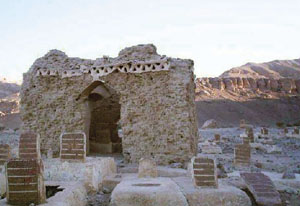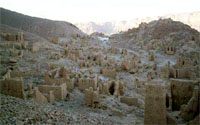
The ruins of Al-Sunahjeh [Archives:2007/1013/Last Page]
January 4 2007
 |
 |
Tarim, Hadramout
[email protected]
Located approximately 22 kilometers from Sayoun, Al-Sunahjeh village is in southeast Wadi Tarbh, a branch of the vast Wadi Hadramout. With ruins extending east and southeast of Wadi Tarbh, the village stands above a number of rocky highlands, as well as the valley's expanse, with some parts rising approximately 40 meters above it.
At approximately 350 x 150 meters, the village contains numerous mosques and other buildings, the most important of which is a castle located on the southeast side with walls built of mud and plastered with gypsum inside and out. Some buildings have more than one floor.
The village also has a drainage system made of pottery, shaped like pipelines and enclosed by stones. Perhaps this type of drainage system was used during the rainy season.
Al-Sunahjeh's buildings exhibit architectural elegance, with a variety of edged and trilateral or square entrances. They've also uncovered arrows and other architectural elements.
The settlement includes more than six mosques in different areas, all nearly similar in style. The most important is located on the north side of the village. The 15.5 x 17.3-meter mosque is rectangular, with 40 cm.-thick mud brick (lebn) walls, except for the 80 cm.-thick Kiblah wall.
It contains two entrances, the first of which is in the east and the other on the northern side, with an approximate 1.75 cm. width. The mosque is surrounded by a yard on the eastern and southern sides, as well as another small mosque, believed to have been earmarked for women, on the south side of the mosque. Additionally, there are bathrooms and a well in front of these mosques.
The first mosque contains a cedar platform dating to 673 A.D., the same date the mosque was built. Decorated with various geometric decorations, villagers moved the rostrum into their recently-built mosque before it later was transferred to the Sayoun Museum.
A cemetery lies 100 meters south of the village ruins, with gravestone inscriptions dating back to 1037 A.D., meaning that the settlement on the continent began in the early seventh century and nearly was abandoned in the 11th century.
Al-Sunahjeh village ruins depict an Islamic integrated village that began with religious buildings, defensive bunkers and residences, which visitors easily can visit in order to imagine how it once was filled with movement and vitality when it was inhabited.
——
[archive-e:1013-v:14-y:2007-d:2007-01-04-p:lastpage]


